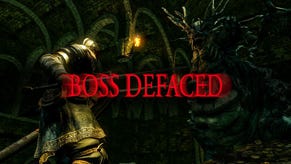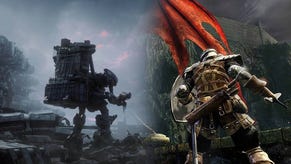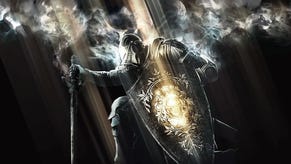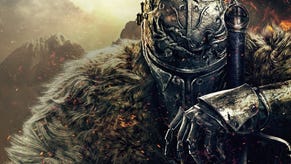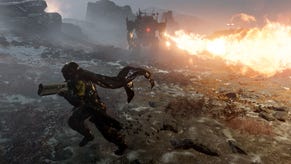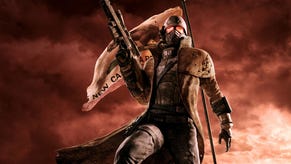Tough love for all – Hands-on with Dark Souls
The sequel to one of the most challenging and gratifying games of recent years is set to launch in October. Stace Harman ventured into its depths and, remarkably, lived to tell the tale. Hands-on impressions inside.
I’m not sure that my PS3 controller’s L1 button has ever seen as much action as it did during the 80-odd hours that constituted my first play through of Demon’s Souls.
Many of you reading will likely recall a similar experience but for those who did not play From Software’s 2009 behemoth – 2010 in PAL territories – or are not in the habit of memorising controller layouts, L1 is used to raise your shield and in Demon’s Souls you raise your shield a lot.
You raise your shield when you can see an enemy or hear an enemy. You raise your shield when entering or exiting a tunnel, room, cave, swamp, prison block or mine. Mostly, then, you raise your shield all of the time because if it’s not an enemy that’s trying to kill you, it’s one of the many environmental traps.
As you may have heard, Demon’s Souls is challenging but, with the possible exception of the poison swamp in the Valley of Defilement towards the end of the game, it’s never difficult to the point that it shreds your sanity or instigates rage quit.
In this respect, Dark Souls looks to follow the path trodden by its predecessor: one that is punishing but fair, challenging but deeply gratifying. Where the early levels of Demon’s Souls sought to teach you the value of caution and that impatience can be fatal; Dark Souls reinforces the value of a good defence and reminds you that demons are a sneaky bunch and will find many a nook and cranny to lie in wait, ready to ambush you.
Have fun storming the castle
My hands on with Dark Souls begins in the grounds of a castle, moss covered flagstones and the deep pink and purple of a sunset lending more warmth to the environment than was seen throughout much of Demon’s Souls. The emaciated and inconsolable folk that are wandering around the castle grounds suggest this place is far from welcoming, however. In the Solaire of Astora, one of the two new classes alongside the Black Knight, I look to have a character balanced for melee combat and the occasional bit of spell casting and so off I go to pit my wits against assorted nasties; sword in hand, inventory stocked and finger firmly on L1.
Sure enough, it’s not long before my shield sees some action repelling the blow of an unseen assailant that lurches from the shadows hoping to cut short my life. Much like Demon’s Souls, it pays to be mindful of your surroundings and trying to swing a broadsword in the tight confines of some of the narrower corridors of the castle causes it to glance harmlessly off the walls, necessitating a switch to a smaller weapon with which to jab.
It’s evident that the castle has multiple routes through it, one of which: a wide, exposed walkway, would perhaps look a lot more appealing were it not for the large wyvern skulking at the other side. The telltale signs of broken bodies lying halfway across the bridge tempt me with the glint of unknown treasures. Progressing a few steps onto the bridge causes the wyvern rise from its crouched position and it’s clear that this is a fight for later, my Demon’s Souls training reminding me that some areas that you have access to early on in the game are meant to be tackled only when you’ve leveled up sufficiently to take on the challenge.
Not that the alternative route that I take is a walk in the park; presenting a wide array of beasts and demons from an armour clad boar to a large knights with larger swords. A demon priest conjures up zombie-like minions that need to be lured into a narrow corridor and dealt with one at a time to prevent them overpowering me by sheer weight of numbers.
The variety and threat of the different types of demons means an array of tactics are required as I inch my way through the castle. The control scheme remains largely unchanged and you’re still rewarded with a powerful counter blow if you’re able to successfully parry an enemy’s incoming attack.
Pressing circle enables you to leap backwards or dive to the side and, although I don’t have access to the inventory screen in this demo build, it seems likely that the weight of your equipment will once again determine how light on your feet you are. An intriguing addition to the move set is the ability to perform a long jump if you press circle whilst sprinting, I don’t have any cause to use it but it’s not difficult to imagine that this will be necessary to traverse certain parts of the environment, or to escape traps or enemies.
Relight my fire
On balance, the enemies I encounter feel slightly tougher than those found in Demon’s Souls, largely on account of the variety in their attack patterns. This is perhaps part of what will make Dark Souls a more challenging game, but it’s not all doom and gloom.
Beacon fires are scattered throughout the levels, serving a number of uses. The primary of which is to act as a checkpoint: if – or rather when – you die you’ll restart from the last beacon fire that was lit. It’s also worth noting at this point that there’s no soul form this time around; upon dying you restart in full flesh and blood form, though you’ll still need to make it back to the bloodstain left at the location of your death if you are to reclaim your souls, which form the game’s currency.
The fires also act as place to replenish your spell stock as there’s no magic meter, not for the character I’m playing as, at least. Instead, there is a finite number of each spell type which, once used, must be replenished at the fireside. You can also gain additional items and healing potions at the beacon fires by trading the game’s secondary currency: humanity.
Much like Demon’s Souls, it pays to be mindful of your surroundings.
Humanity is gained by destroying the powerful end of level demons as well as repelling a hostile invasion by another player or, as the invading player, killing the hosting player. Those worried that the beacon fires will lessen the challenge should not fear: all of the level’s enemies respawn when you do and, what’s more, they respawn each time you use a beacon fire - so anyone foreseeing frequent dashes to and from the fires to replenish spells and healing items will have to fight their way back through all of the things that caused them to use those spells and healing items in the first place.
My Dark Souls journey ends with a rooftop boss fight against two large gargoyles, one armed with a trident and a battle axe for a tail, the other breathing fire. Neither seems open to negotiation and so, a relatively small number of deaths later, I’ve battled my way to the end of the demo level. It’s taken around an hour and I feel relieved, elated and hungry for more.
Dark Souls, like its predecessor, looks set to offer a tough fight: it will undoubtedly kill you many times over as you explore its sprawling loading-screen-free levels and it will refuse to patronise you or hold your hand but in doing so it will teach you how to be a better player.
And you can’t say fairer than that.
Dark Souls is set for release on PS3 and 360 on October 4 in the US and October 7 in PAL territories.




